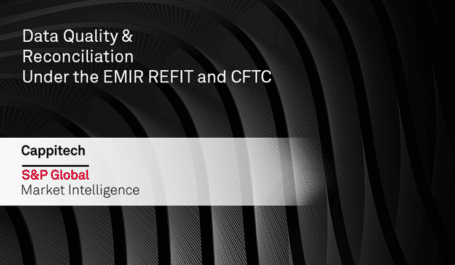
Compliance Reconciliation
Reconcile your transaction data for the entire regulatory submission process
Reconciliation just like the regulator wants
With the ever-increasing data quality checks conducted by regulators, it is imperative that reporting firms have in place the necessary tools and processes to verify reporting quality on a regular and ongoing basis. Cappitech offers several reconciliation options to choose from to ensure the accuracy and completeness of your data:
End of Day Trade Repository Reconciliation
This reconciliation process is designed to identify inaccurate and incomplete transaction reporting data between your books and records, and the Trade Repository.
All trades coming from the system of record are ingested by Cappitech. Eligibility, Determination and Validation rules are run against those trades to determine what should have been reported to the Trade Repository.
Once the universe of eligible trades is established, Cappitech builds an end of day position file by aggregating all the eligible trades into positions. Incidentally, some clients prefer to send us their EOD position files which negates the requirement to aggregate on our end. Those positions in Cappitech are then compared, field by field against the TSR.
MiFID Reconciliation
The Cappitech solution allows you to compare trade data to transaction reports with line-by-line details of submissions to trades. The final XML reports received by the FCA are reconciled to MiFIR submissions and ensure you comply with best practices of monitoring transaction reporting.
Customized Reconciliation
For those who need a bespoke reconciliation module, Cappitech is able to offer a field-by-field comparison between any two sources. This can include comparing books and records against your counterparty submissions, comparing against a clearing broker, internal systems, etc.
Pairing & Matching (EMIR & SFTR)
This reconciliation module is a visual of historical statistics of unpaired, paired, matched and non-pairable submissions which includes, for example, per LEI details, granular details per UTI of mismatched fields and values and filters to query by date, pairing status, submission message and counterparty.
Benefits
What is regulatory reconciliation?
Regulatory reconciliation is the process of comparing front office transactions to those submitted to regulators and trade repositories under transaction reporting for accuracy and completeness of reporting. The review should include checks that all trades that are under scope are in fact reported, transactions out of scope aren’t being reported and that data received by regulators matches sent submissions.
Is trade/transaction reconciliation a requirement by the regulator?
Under MIFID II regulation, there is a requirement within RTS 22 Article 15 Clause 3: “Investment firms shall have arrangements in place to ensure that their transaction reports are complete and accurate. These arrangements shall include testing of their reporting process and regular reconciliation of their front-office trading records against data samples provided to them by their competent authorities to that effect.”
Other forms of transaction reporting regulation also include within their legislation requirements for firms to have in place processes for maintaining accuracy and timeliness of reports.
Why do we need to reconcile with the regulator’s data?
While comparing the number of transactions sent vs. the number of transactions accepted by the regulator, you can identify many reporting issues including identifying rejections or discovering records being missed.
What is a three-way reconciliation?
Three-way reconciliation is a comparison between front office data, information sent to an ARM or service provider and reports collected by a trade repository or regulator.
Learn More




